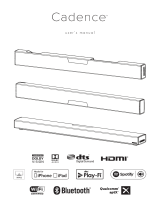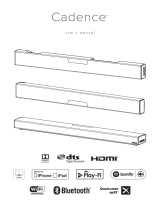
ENGLISH
Specication
Power consumption
y Refer to the main label.
AC adapter
y Model: DA-50F25
y Manufacturer: Asian Power Devices Inc.
y Input: 100 - 240 V ~ 50 - 60 Hz
y Output: 25 V 0 2 A
Dimensions (W x H x D): Approx. 1060.0 mm x 57.0 mm x 119.0
mm (41.8 inch x 2.2 inch x 4.7 inch)
Bus Power Supply (USB): 5 V 0 500 mA
Amplier (Total RMS Output power): 440 W RMS
OPEN SOURCE SOFTWARE NOTICE INFORMATION
To obtain the source code under GPL, LGPL, MPL, and other open
source licenses, that is contained in this product, please visit
http://opensource.lge.com.
In addition to the source code, all referred license terms, warranty
disclaimers and copyright notices are available for download.
LG Electronics will also provide open source code to you on
CD-ROM for a charge covering the cost of performing such
distribution (such as the cost of media, shipping, and handling)
This offer is valid for a period of three years after our last
shipment of this product. This offer is valid to anyone in receipt of
this information.
FRANÇAIS
Caractéristiques
Consommation électrique
y Reportez-vous à l’étiquette principale.
Adaptateur c.a.
y Modèle : DA-50F25
y Fabricant : Asian Power Devices Inc.
y Entrée : De 100 à 240 V c.a.; 50/60 Hz
y Sortie : 25 V c.c; 2 A
Dimensions (L x H x P) : Environ 1 060,0 mm x 57,0 mm x 119,0
mm (41,8 po x 2,2 po x 4,7 po)
Alimentation bus (USB) : 5 V c.c; 500 mA
Amplicateur (puissance de sortie RMS totale) : 440 W RMS
Informations sur les logiciels libres
Pour obtenir le code source conformément aux dispositions de la
licence publique générale, de la licence publique générale limitée,
de la licence publique Mozilla et de toute autre licence régissant
les logiciels à code source libre contenus dans cet appareil, visitez
le site http://opensource.lge.com.
En plus du code source, toutes les dispositions de licence, les
exonérations de garantie et les avis de droits d’auteurs peuvent
aussi être téléchargés.
LG Electronics mettra également à votre disposition le code
source libre sur CD-ROM pour un prix couvrant le coût de
la distribution (coût du support, de l’expédition et de la
manutention) sur simple demande par courriel à l’adresse
Cette offre est valable pendant une période de trois ans à
compter de la date de la dernière distribution de ce produit. Cette
offre est valide pour quiconque possède cette information.
HDMI OUT
a
b
D
E
C
B
A
a
C
c
c
c
HDMI IN
(ARC)
HDMI IN
OPTICAL
OUT
Replacement of Battery
Remplacement des piles
FRANÇAIS
Installation et utilisation de l’appareil
Veuillez lire attentivement ce manuel avant d’utiliser votre appareil et conservez-le pour référence ultérieure.
Pour afcher les instructions sur les fonctions avancées, accédez à http://www.lg.com ou bien balayez le code
QR et téléchargez le Manuel de l'utilisateur. Certaines parties de ce manuel peuvent ne pas correspondre à
votre appareil.
A Barre de son
B Récepteur de télécommande / Afchage de l’état
C Haut-parleurs arrière / récepteur sans l (vendus séparément,
SPK8-S)
D Caisson de basses sans l - Installez-le près de la barre de
son.
E Périphérique externe - (lecteur Blu-ray, console de jeu, etc.)
a Connectez la barre de son à votre téléviseur à l’aide d’un câble optique ou d’un câble HDMI.
b Si vous utilisez un appareil externe (p. ex. lecteur Blu-ray, console de jeu), connectez-le à la barre de son à l’aide d’un câble HDMI.
c Si vous avez acheté les haut-parleurs arrière et le récepteur sans l vendus séparément, connectez les haut-parleurs arrière au
récepteur sans l à l’aide d’un câble haut-parleur. Lors de la connexion des haut-parleurs arrière au récepteur sans l, connectez le
câble rayé noir à la borne négative de chaque haut-parleur et l’autre câble à la borne positive de chaque haut-parleur.
d Connectez l’alimentation dans l’ordre suivant : caisson de basses sans l [ récepteur sans l [ barre de son. Mettez ensuite
la barre de son sous tension. Lorsque la connexion est automatiquement établie avec la barre de son, les indicateurs DEL sur le
caisson de basses sans l et le récepteur sans l s’allument en vert.
e Utilisation de l’appareil avec votre téléviseur
A Appuyez sur le bouton Fonction
plusieurs fois jusqu’à ce que « OPT/HDMI ARC » apparaisse sur l’afchage d’état.
B Dans les paramètres de votre téléviseur, réglez le haut-parleur de sortie sur [HDMI ARC], [Optique] ou [Haut-parleur externe].
C Lorsque le téléviseur est correctement connecté à l’appareil, « OPT », « ARC », ou « E-ARC » apparaîtra sur l’afchage d’état
avec un son.
f Connexion de l’appareil à votre téléphone intelligent par Wi-Fi
A Connectez votre téléphone intelligent au Wi-Fi.
B Installez l’application LG Wi-Fi Speaker à partir de Google Play ou de l’App Store.
C Exécutez l’application LG Wi-Fi Speaker et suivez les instructions.
D L’appareil sera connecté à votre téléphone intelligent, et vous pourrez le commander à l’aide de l’application LG Wi-Fi Speaker.
g Connexion de l’appareil à votre téléphone intelligent par Bluetooth
A Touchez le bouton Paramètres
sur votre téléphone intelligent et sélectionnez Bluetooth. Activez la fonction Bluetooth.
( Inactive > Active)
B Appuyer sur le bouton Jumeler Bluetooth
. Au bout d’un moment, « BT READY » apparaît sur l’afchage d’état.
C Trouvez et touchez « LG_Speaker_SP8YA_XXXX » ou le nom que vous avez enregistré dans l’application Google Home.
D Lorsque l’appareil est connecté à votre téléphone intelligent par Bluetooth, vous pouvez voir l’afchage d’état changer de
« PAIRED » [ « Nom du périphérique connecté par Bluetooth » [ « BT ».
Si l’indicateur DEL au dos du caisson de basses sans l ou à l’avant du récepteur sans l est rouge, cela signie que la barre de son n’est
pas connectée aux haut-parleurs. Si c’est le cas, connectez-les dans l’ordre suivant.
A Appuyez sur le bouton Alimentation
sur la barre de son pour la couper.
B Appuyez sur le bouton PAIRING (Pairing) au dos du caisson de basses ou du récepteur sans l déconnecté. Vériez si chaque indicateur DEL
clignote en vert.
- Si l’indicateur DEL au dos du caisson de basses sans l est toujours rouge, appuyez de nouveau et maintenez enfoncé le bouton au dos du
caisson de basses.
C Appuyez sur le bouton Alimentation
sur la barre de son pour l’allumer.
D Lorsque la connexion est établie, l’indicateur DEL au dos du caisson de basses sans l ou à l’avant du récepteur sans l s’allume en vert.
Placez la barre de son, le caisson de basses et le récepteur sans l à 1 m (3,3 pi) au minimum d’un appareil (p. ex. routeur sans l, four à micro-
ondes) pour éviter toute interférence avec la connexion sans l.
y Selon la source, certains haut-parleurs n’émettront aucun son. Sélectionnez le mode audio CINEMA (Cinéma) pour activer tous les haut-
parleurs.
y La conception et les caractéristiques peuvent être sujettes à modication sans préavis.
y Google Play est une marque déposée de Google LLC.
ENGLISH
Installing and Using the Product
Please read this manual carefully before operating your set and retain it for future reference.
To view the instructions of advanced features, visit http://www.lg.com or scan QR code and then download
Owner’s Manual. Some of the content in this manual may differ from your product.
A Sound bar
B Remote Control Receiver / Status Display
C Rear Speakers / Wireless Receiver (Sold separately, SPK8-S)
D Wireless Subwoofer - Install it close to the sound bar.
E External Device - (Blu-ray player, game console, etc.)
a Connect the sound bar to your TV via an optical cable or an HDMI cable.
b If you are using an external device (ex. Blu-ray player, game console, etc.), connect it to the sound bar via an HDMI cable.
c If you purchased the rear speakers and wireless receiver separately, connect the rear speakers to the wireless receiver via a speaker
cable. When connecting the rear speakers to the wireless receiver, connect the black striped cable to the negative terminal of each
speaker and the remaining cable to the positive terminal of each speaker.
d Connect to power in the following order: wireless subwoofer [ wireless receiver [ sound bar. Then, turn on the sound bar. When
the connection is automatically established with the sound bar, the LEDs on the wireless subwoofer and the wireless receiver will
light up in green.
e Using the product with your TV
A Press the Function
button repeatedly until “OPT/HDMI ARC” appears on the status display.
B On your TV’s settings, set the output speaker to [HDMI ARC], [Optical], or [External Speaker].
C When the TV is properly connected to the product, “OPT”, “ARC”, or “E-ARC” will appear on the status display with a sound.
f Connecting the product to your smartphone via Wi-Fi
A Connect your smartphone to Wi-Fi.
B Install the LG Wi-Fi Speaker app on Google Play or the App Store.
C Run the LG Wi-Fi Speaker app and follow the instructions.
D The product will connect to your smartphone and you can control the product with LG Wi-Fi Speaker app.
g Connecting the unit to your smartphone via Bluetooth
A Tap the Settings
button on your smartphone and select Bluetooth. Turn on the Bluetooth function. ( Off >
On)
B Press the Bluetooth pair
button. After a moment, you will see “BT READY” on the status display.
C Find and tap “LG_Speaker_SP8YA_XXXX” or the name you registered on the Google Home app.
D When the product is connected to your smartphone via Bluetooth, you can see the status display change from “PAIRED” [
“Connected Bluetooth device name” [ “BT”.
If you see a red LED on the back of the wireless subwoofer or on the front of the wireless receiver, it means that the sound bar is not
connected to the speakers. If this is the case, connect them in the following order.
A Press the Power
button on the sound bar to turn it off.
B Press the PAIRING (Pairing) button on the back of the disconnected wireless subwoofer or wireless receiver. Check if each LED blinks green.
- If you still see a red LED on the back of the wireless subwoofer, press and hold the button on the back of the subwoofer again.
C Press the Power
button on the sound bar to turn it on.
D When the connection is established, you will see a green LED light on the back of the wireless subwoofer or on the front of the wireless
receiver light up in green.
Keep the sound bar, the subwoofer and wireless receiver away from the device (ex. wireless router, microwave oven, etc.) over 1 m (3.3 ft) to
prevent wireless interference.
y Some speakers may not make sound depend on the input source. Select CINEMA sound mode to listen through all speakers.
y Design and specications are subject to change without notice.
y Google Play is a trademark of Google LLC.
SP8YA.DCANLLK_SIMPLE (Sheet)_MFL71795709.indd 5-8 2021-01-29 8:53:40



